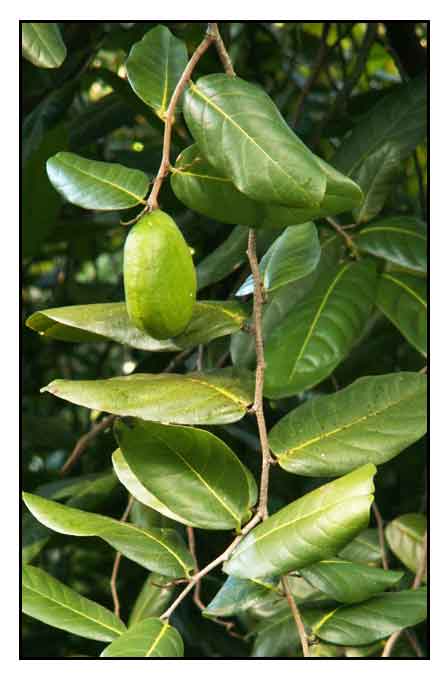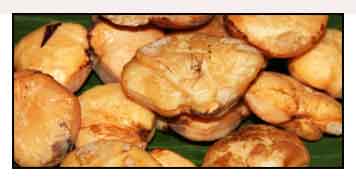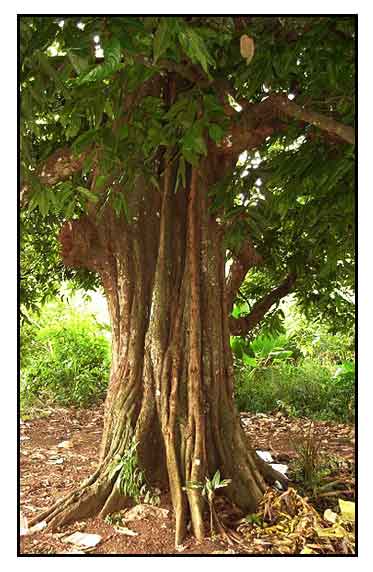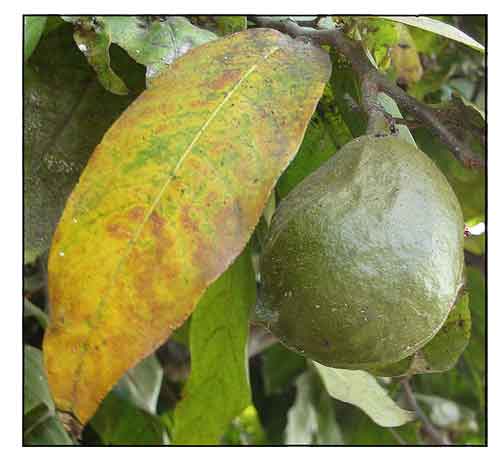 Gen info Gen info
- Inocarpus is a small genus of flowering plants in the legume family, Fabaceae. It comprises four species in Malesia and the South Pacific: Inocarpus ademanus, I. fagifer, I glabellus, and I. papuanus.
-
Inocarpus fagifer, commonly known as the Tahitian chestnut or Polynesian chestnut, is a species of flowering plant in the subfamily Faboideae of the legume family, Fabaceae. It is the only edible and culturally important member of the genus Inocarpus. (4)
- Etymology: The genus name Inocarpus derives from Greek words inos (fiber) and karpos (fruit), referring to the character of the fruit. The species epithet derives from Latin fagus (beach tree like) and ferre (to bear). (12)
- Butuan snippet: According to Cembrano's "Patterns of the Past: The Ethno Archaeology of Butuan" (1998(, the kayam chestnuts were seasonal calorie produces and source of nourishment for the early inhabitants of Butuan. Excavated fragments of fruit cover showed the seeds were obtained by chopping across the fruit. Today, Butuanons slice away at the pericarp and slit open the fruit cover to extract the whole seed. Banza elders in Butuan believe the tree was introduced by Polynesian traders. (17)
Botany
• Inocarpus fagifer is an evergreen tree growing to a eight of 20 m with a large and dense canopy. Bole is buttressed at the base, short, thick, irregular, up to 60 cm in diameter. Taproot is shallow with and well-formed network of lateral roots. Bark is rough and brown, increasing gray with age. Branches are spirally arranged, with secondary branches forming a dense network within the canopy. Leaves are dark green, simple, oblong and leathery. , 15 to 30 cm long, 7 to 13 cm wide, pointed apex and lobed base. Petiole is 5 mm long. Flowers are white, cream, or pale yellow, fragrant, and growing in clusters at the end of branches and twigs. Fruits are slightly flattened, irregularly ovoid, rounded or oblong, and flanged at one end, 4 cm to 13 cm long, 3 to 12 cm wide, occurring singly or in clusters. Seed is white, kidney-shaped, 2 to 7 cm long and 1.6 to 4 cm wide.(3) (4)
 • A tree, up to 30 m tall and often producing several stems. Buttresses can grow up to 3 m long if present. Bark is dark brown, slightly flaky and inner bark have red sap. Foliage: Leaves are oblong to ovate (10 – 50 cm long and 4 – 18 cm wide), in alternate arrangement and appears drooping. Leaves are pink when young and becoming shiny yellowish – green as it mature. Petiole is 0.5 – 1.5 cm long and stipule is small. Flowers: Inflorescence is 1 – 17 cm long and occurs in the axillary position. Flowers are very fragrant and small, comprising of 5 creamish white recurved petals, and 10 stamens in two series. Calyx is tubular and has 2 – 5 teeth. Fruit: Seed pod shape is variable, usually about 5 – 10 cm long and 5 – 8 cm wide, 1-seeded and does not split open. Seed pod is green and ripens orange-brown. Seed is about 8 cm long. (12) • A tree, up to 30 m tall and often producing several stems. Buttresses can grow up to 3 m long if present. Bark is dark brown, slightly flaky and inner bark have red sap. Foliage: Leaves are oblong to ovate (10 – 50 cm long and 4 – 18 cm wide), in alternate arrangement and appears drooping. Leaves are pink when young and becoming shiny yellowish – green as it mature. Petiole is 0.5 – 1.5 cm long and stipule is small. Flowers: Inflorescence is 1 – 17 cm long and occurs in the axillary position. Flowers are very fragrant and small, comprising of 5 creamish white recurved petals, and 10 stamens in two series. Calyx is tubular and has 2 – 5 teeth. Fruit: Seed pod shape is variable, usually about 5 – 10 cm long and 5 – 8 cm wide, 1-seeded and does not split open. Seed pod is green and ripens orange-brown. Seed is about 8 cm long. (12)
 Distribution Distribution
- Native to the Philippines. (1) (According to Co's Digital flora of the Philippines: Cultivated, not naturalized.) (10)
- Also native to Bismarck Archipelago, Borneo, Christmas I., Fiji, Jawa, Lesser Sunda Is., Malaya, New Guinea, Santa Cruz Is., Society Is., Solomon Is., Sulawesi, Sumatera, Tonga, Tubuai Is., Vanuatu, Wallis-Futuna Is. (1)
Constituents
- Study for the fatty acids, minerals, phenolics, and vitamin contents yielded a slight predominance of unsaturated over saturated fatty acids. Mineral analysis yielded substantial concentrations of copper, magnesium, manganese, potassium and zinc with 19.32, 1823.21, 8.44, 23308.41 and 77.99 mg/kg of dry matter, respectively. Ferulic and coumaric acids were the most abundant phenolics (3.23 and 1.48 mg/kg DM, respectively. Flavonoids, isofavonoids and coumestrol were present. Vitamins niacin and riboflavin were 131.80 and 4.47 mg/kg DM. (5)
- Methanol extract yielded secondary metabolites: alkaloids, flavonoids, triterpenoids or steroids, saponins and tannins. (see study below) (16)
Properties
- Studies have suggested nutritional, antioxidant. antiatherosclerotic, antidiabetic, phytoremediative properties.
Parts used
Bark, leaves, seeds..
 Uses Uses
Edibility
- Seeds are edible, raw or cooked. Boiled before ripening , they have the flavor of chestnut.(3)
- Seeds cooked by roasting, grilling, boiling, and baking. In Papua New Guinea, Solomon Islands and in Polynesia, cooked kernels are mashed into a pudding. (4)
- Caution: The seed is reported by some as toxic when raw, but edible when cooked.
(4)
- Grated seeds used for making cakes, breads and pudding. However, kernels are reportedly slightly indigestible, and when cooked, is highly perishable with a short shelf-life.(3)
- In Tonga, juice from mesocarp of green fruits used to treat insect bites and burns.
Folkloric
- No reported medicinal use in the Philippines.
- Elsewhere, use for the treatment of burns, diarrhea, scabies, teething problems in infants, pneumonia, stomach pains, bone pains, malarial fever and internal bleeding.
Dried bark mixed with coconut oil applied to bone fractures. (3)
- In the Solomon Island, the bark is grated and mixed with coconut milk or bark sap to treat urinary tract infections. In Borneo and Java, tannin from the bark is consumed as a remedy for intestinal disorders. (12)
- Leaves used for wound healing.
- The Chuuk of Micronesia reports on the use of the plant for baby leg strengthening: Dead leaves from a fallen tree is put on a fire, and the legs of a two or three month old baby are smoked until the leaves turn into ashes, with the belief that the baby will stand and walk by the seventh month. (13)
- Bark used to treat sickness relapses. Infusion of bark used for treating burns, diarrhea, and teething problems in infants. Bark decoction used for scabies. Extracts of heated bark scrapings used for treatment of pneumonia. Leaf juice used for treatment of postpartum weakness and fish poisoning. (3)
Others
- Thatching: Leaves used for thatching. (4)
- Fuel: Branches used as firewood. Green wood burned to dry copra. (4)
- Crafts: Wood used for carving and making tool handles, canoes, and various light construction. (4) In the Solomon Island, large leaves are sown together to make sails and wrapping food. (12)
- Agroforestry: Trees in coastal and soil stabilization; used as shade-tree or windbreaker. (4)
- Superstition / Mythology: In Samoa, humans believed to ave originated from the chestnut tree. In Vanuatu, the first woman was a man emasculated by hot leaves applied to the genitalia. (4)
- Fodder: Kernel use as feed for free-range chickens. (14)
Studies
• Fatty Acids / Phenolics / Minerals / Vitamins: Study reported on the fatty acids, phenolics, and vitamin content of Inocarpus fagifer. Results yielded a slight predominance of unsaturated over saturated fatty acids. Mineral analysis yielded substantial concentrations of copper, magnesium, manganese, potassium and zinc with 19.32, 1823.21, 8.44, 23308.41 and 77.99 mg/kg of dry matter, respectively. Ferulic and coumaric acids were the most abundant phenolics (3.23 and 1.48 mg/kg DM, respectively. Flavonoids, isofavonoids and coumestrol were present. Vitamins niacin and riboflavin were 131.80 and 4.47 mg/kg DM. (5)
• Antioxidant / Seeds: Study evaluated the antioxidant compounds i.e., linoleic acid, ethyl linoleic, ethyl oleic, and homoptero carpine in an ethanol extract of gayam seed to prevent atherosclerosis through increase of SOD3 expression and decrease of MDA concentration in Wistar rats with high cholesterol. Results showed the ethanol extracts in doses of 50-150 mg/kbw significantly increased SOD expression in aorta endothelial cells and significantly decreased MDA (p<0.05). (6)
• Antiatherosclerotic Effect in Hyperlipidemic Rats / Stem Bark: Study evaluated the anti-atherosclerotic effect of n-butanol extract of stem bark through biomaker SOS-2 and SOD-3 expression in aortic endothelial cell of hypercholesterolemic wistar rats. At dose of 50 mg/kbw there was significant (p<0.05) increased expression of SOD-2 aortic endothelial cells. The SOD-3 effect was not significant )P>0.05). (7)
• Effect of Pre-Gelatiinization on Physiochemical and Functional Properties of Gayam Flour: Study on pre-gelatinization treatment pf gayam flour. Results showed significant differences in physiochemical and functional properties in pre-gelatinized flour with respect to starch, amylose content, color, microstructure, water holding capacity, oil holding capacity and pasting properties. Pre-gelatinization increased the whiteness index, water holding capacity and swelling power. (9)
• Antioxidant / Antihypercholesterolemic / Seeds: A randomized post-test study of ethanol extract of seeds in doses of 50-100 mg/kbw decreased the expression of positive TNF-α significantly (p<0.05), but not significantly (p>0.05) for the expression of positive IL-6 liver cell hypercholesterolemia in Wistar rats. Antioxidants compounds from the seeds were linoleic acid, ethyl linoleic, ethyl oleic, and homopterocarpine. (15)
• Antidiabetic: Study evaluated the antidiabetic active compound content of polar and non-polar extracts of skin Coweba (Inocarpus fagifer) as basis for development of antidiabetic drugs from local resources. Extract yielded secondary metabolites: alkaloids, flavonoids, triterpenoids or steroids, saponins and tannins. The ME showed an α-glucosidase inhibitory activity of 75.86% with IC50 of 0.814 ppm. Results suggest potential as raw material for development of natural herbal antidiabetic drugs. (16)
• Fruit as Mochi Filling: Study evaluated the potential for Gayam fruit to be processed into stuffing in Mochi. Gayam fruit has a balance of nutrients, fat 2.15% and protein 11.63%. Study reports on the procedure: preparation, implementation and final process in making Mochi stuffing using the fruit. (18)
• Heavy Metal Adsorbent of Heavy Metal from Wastewater: Tahitian chestnut (Inocarpus fagifer) has been utilized as adsorbent to eliminate heavy metal ions in wastewater. Study evaluated Tahitian chestnut wood sawdust chemically modified by alkali solution from potassium hydroxide and sodium hydroxide to enhance the adsorption capacity of sawdust. Results showed kinetic of adsorption PB(II) ions onto adsorbent wood sawdust was well illustrated by Lagergren 2nd order with determination coefficient (R2) of 0.9496. (19)
• Antiatherosclerotic / Seeds: Study evaluated Inocarpus fagiferus seeds extract for preventive effect on early atherosclerosis in wistar rats. After the study, rats were euthanized and the aorta analyzed for data on ICAM-1, SOD-2, TNF-α, and IL6. Results showed the seeds extract at 50 mg/kbw was able to prevent atherosclerosis in rats with a decrease in ICAM-1, TNFα and IL-6 expression of aortic endothelial cells, and significantly increased SOD-2 expression (p<0.05). (20)
Availability
- Wild-crafted.
- Cultivated for its edible seeds.
- Seeds in the cybermarket.
|

![]()



 Gen info
Gen info • A tree, up to 30 m tall and often producing several stems. Buttresses can grow up to 3 m long if present. Bark is dark brown, slightly flaky and inner bark have red sap. Foliage: Leaves are oblong to ovate (10 – 50 cm long and 4 – 18 cm wide), in alternate arrangement and appears drooping. Leaves are pink when young and becoming shiny yellowish – green as it mature. Petiole is 0.5 – 1.5 cm long and stipule is small. Flowers: Inflorescence is 1 – 17 cm long and occurs in the axillary position. Flowers are very fragrant and small, comprising of 5 creamish white recurved petals, and 10 stamens in two series. Calyx is tubular and has 2 – 5 teeth. Fruit: Seed pod shape is variable, usually about 5 – 10 cm long and 5 – 8 cm wide, 1-seeded and does not split open. Seed pod is green and ripens orange-brown. Seed is about 8 cm long. (
• A tree, up to 30 m tall and often producing several stems. Buttresses can grow up to 3 m long if present. Bark is dark brown, slightly flaky and inner bark have red sap. Foliage: Leaves are oblong to ovate (10 – 50 cm long and 4 – 18 cm wide), in alternate arrangement and appears drooping. Leaves are pink when young and becoming shiny yellowish – green as it mature. Petiole is 0.5 – 1.5 cm long and stipule is small. Flowers: Inflorescence is 1 – 17 cm long and occurs in the axillary position. Flowers are very fragrant and small, comprising of 5 creamish white recurved petals, and 10 stamens in two series. Calyx is tubular and has 2 – 5 teeth. Fruit: Seed pod shape is variable, usually about 5 – 10 cm long and 5 – 8 cm wide, 1-seeded and does not split open. Seed pod is green and ripens orange-brown. Seed is about 8 cm long. ( Distribution
Distribution
